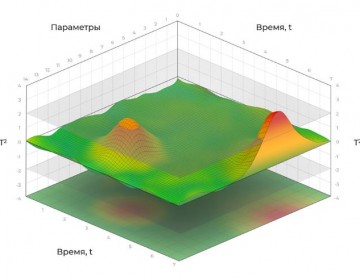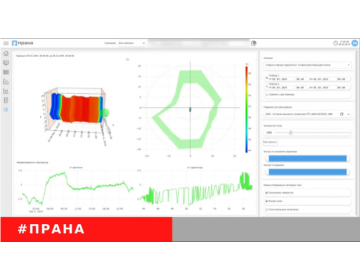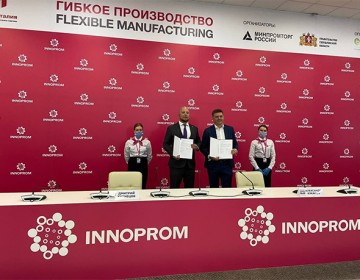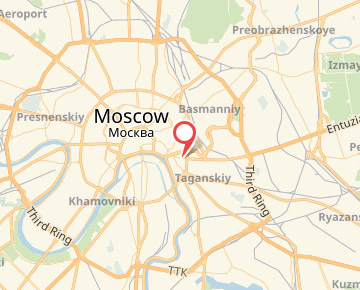Industrial Internet for black box
Stimul website on the PRANA prognostics system
Author: Irik Imamutdinov
Based on its own algorithms, ROTEC has developed a remote monitoring and prognostics system for power equipment. The main idea is not so much to track the operating parameters of a rotary machine - many manufacturers are able to do this - but to obtain an advance and accurate prediction of its future state
The situation center at ROTEC will soon begin to analyze the state of the main equipment of two dozen power units at 15 combined-cycle TPPs.
The name of the system, PRANA, is an abbreviation of Predictive Analytics. Whether this was intentional word play or not, the word "prana" also has another definition well known to yoga lovers; it is the invisible life force that permeates the universe. From this we can even draw a reference to the World Wide Web. The company itself states that its creation is a product developed in Russia but which is already being used in practice in the Industrial Internet sphere.
As you may know, the term “Industrial Internet” was coined by Professor Klaus Schwab, Founder and Executive Chairman of the World Economic Forum, who mentioned it in a speech he gave at the 46th session of the WEF in January 2016. He later used the term in a book he published, titled The Fourth Industrial Revolution, in which he describes the main parameters characterizing the new economy based on information technologies (for details see The Second Digital Campaign).
It turns out that Russian developers of such technologies are keeping up with the new revolution. According to Mikhail Lifshits, Chairman of the Board of Directors of ROTEC JSC, who initiated the creation of the Prana system, “The Industrial Internet is just not a trendy topic for us. We started this six years ago, and introduced the PRANA system for diagnostics and prognostics of power equipment for the first time in 2015. The experience of operating the system on four gas-turbine installations shows that we can begin to track the development of a malfunction long before an actual breakdown or accident. This means that, over time, we can expect a transition from routine maintenance to early repairs. If you know which equipment may break down and when, then repairing it after the accident is not necessary, since it can simply be prevented."
So far, PRANA has already analyzed about one and a half million hours of operation of complex energy machines such as gas and steam turbines. In practice, the application of the system shows that the system reacts to any change in performance of any of the hundreds of sensors of the gas turbine unit (GTU) within seconds. After 30-80 seconds, the system is able to identify the cause of deviation, determine the incipient defect, its development rate, and predict the amount of time before a malfunction occurs that could lead to an accident. As a result, with a depth of forecast of up to three months, the system can detect up to 80% of defects originating in equipment and eliminate them in advance. The remaining 20% are attributed to defects that develop suddenly, associated with the degradation of materials. Microcracks, for example, are determined only by direct inspection (in particular, during flaw detection). The six-year improvement of PRANA means it can now be adapted to work on many types of industrial equipment - from compressors and pumps to transformers and rolling mills.
Online Analytics
An economy sector as basic as energy was inevitably going to be affected by the development of information technologies. As a result of digitalization, significant changes have occurred in the traditional relationship between equipment manufacturers and power companies.
All sorts of sensors, controllers and software, both those that control the operation of the machines themselves and those built into the enterprise management systems, maintain a constant flow of information about the working equipment. This increases its efficiency and life cycle. This wealth of information predetermined the emergence of prognostics systems with elements of the Industrial Internet - predictive analytics. But this IT abundance confuses even specialists themselves when talking about digitalization as the next stage in the sphere of the Industrial Internet. Often it turns out that most of the projects implemented by them are more related to the category of monitoring systems designed to help station personnel to improve the efficiency of the equipment being serviced.
Another thing is that such projects, though more advanced digital solutions than the traditional types of automated process control systems, are in fact platforms on which the prognostics system itself can deployed. According to Alexander Krymsky, Candidate of Physical and Mathematical Sciences, Deputy Director for Business Development of the PRANA project and developer of its algorithms, in the prognostics systems, the Industrial Internet combines elements such as sensors, actuators, controllers used in automation, together with machine learning technologies, prototyping systems and tools for processing and analyzing large amounts of the data typical of the Internet of Things. In the prognostics system, sensors, equipment, and its information environment are inextricably linked and interact with each other using standard internet protocols to predict, configure themselves, and adapt to changes in real time.
The market of predictive analytics is currently at the initial development stage - both in Russia and around the world. But predictive systems are attracting more and more interest, and the money turnover in this area is growing rather quickly (see Table 1). According to the company Markets and Markets, which in 2016 conducted a study on 'Operational predictive maintenance market — Global forecast to 2020', the global market in this sector will increase to USD 1,884 million by 2020 (from USD 582 million in 2015), taking into account the maintenance analytics systems offered by manufacturers. For example, remote monitoring accounts for around half a billion dollars. Although the absolute figures do not seem that impressive, expert predict that this segment will grow at a high rate in the near future. This forecast is based on a desire among companies to reduce equipment repair costs and downtime while increasing equipment reliability. Even now the average annual growth rates exceed 26%.
The priority sector for using predictive analytics systems at global level is energy, an industry in which the cost of equipment breakdown is extremely high. In other industries, most of the solutions offered are in the field of water supply and drainage, oil and gas processing, as well as in the mining industry.
Modern energy and power engineering facilities are a very complex technological complex, in which even a relatively minor problem can lead to dire consequences, including for the investor. Of course, managers try to control all aspects of equipment operation: to increase the degree of control, accounting, and personnel motivation. It is precisely the serious consequences of an accident that make daily equipment checks necessary, along with operational, routine, and procedural maintenance, but all these efforts may go down the drain because of a sudden emergency situation or errors made by employees. This is evident from the official statistics.
According to the analytical report of the Ministry of Energy of Russia for 2017, the power plants within the county's Unified Energy System experienced 3,801 situations classified as emergencies. A significant portion of them - more than a quarter - involved boiler equipment and another 22% involved turbine equipment. According to expert estimates on the cost of accidents and emergencies, Russian generating companies suffered huge losses in 2017 - more than 15 billion rubles. These are the direct costs of repairing equipment and purchasing spare parts, losses from underproduction of electricity, as well as fines imposed by the market regulator for undersupply of capacity. The most costly breakdowns concern turbine equipment; according to analysts, they caused around 8.5 billion rubles in losses. Generator breakdowns cost the power industry about another 2.4 billion rubles.
With the large-scale implementation of predictive analytics systems like PRANA at power plants across the country, unexpected costs for power engineers can be more than halved. Therefore, in order to mitigate the risk of the human factor, many owners of energy assets are making remote equipment monitoring a high priority on their work agenda, and are already looking at new opportunities in the field of the Industrial Internet of Things in this particular area. According to Alexander Krymsky, the generation of electricity complemented by digital technologies with predictive analytics software, together with the latest equipment, can provide incredible savings, reliability and safety.
Good choice
Cyber-physical systems, which include remote monitoring and diagnostics, are a good example of business transformation using the Internet of Things and mathematical algorithms embodied in specific applications and services, says Mikhail Lifshits. Of course, remote monitoring itself is not an innovation at all; it is used widely by other companies to observe the mode of operation of turbines and monitor deviations from operating parameters. This is part of the service package that has been historically used around the world by equipment manufacturers and generating companies, primarily in the field of gas turbines. Monitoring is a necessary tool for the service provider, which helps to determine the condition of the machine and prepare for carrying out effective maintenance at the power plant itself. For OEMs, it allows to collect data on how its machines are operated and take this information into account when developing new equipment. Therefore, the majority of global manufacturers of gas turbines, as well as companies specializing in the development of industrial control and automation systems (General Electric, Siemens, ABB, Emerson, Honeywell, IBM, Rockwell Automation, SAS, Schneider Electric) are making use of prognostics systems. The process of collecting and transmitting data from power equipment is a fairly well-established process. The next level is to analyze the monitoring data, which is more complicated. But the cutting edge of modern development is the analysis of the technical condition of power equipment using predictive analytics methods.
The PRANA project, aimed at creating such methods, began to take shape when ROTEC started working in the field of servicing gas turbines, which eventually became one of the company's core business areas. The idea of using diagnostics was discussed in the company in December 2010, when a diagnostic unit already existed, says Evgeny Gromak, Manager of the Engineering project. At the time, however, this department was focused on the pumps as part of the rotary equipment. The gas turbine is also a rotor machine, and at Mikhail Lifshits's suggestion, the company began to look closely at the possibility of diagnosing gas turbine equipment and developing the corresponding methods. The idea went beyond just a mobile diagnostics laboratory and the usual equipment diagnostics. The company carefully reviewed the existing approaches to remote monitoring, how they are implemented and what they offer. Initially, the idea was to create a conventional remote monitoring system, in which the diagnosis was based on expert rules. However, after studying the methods of predictive analytics, the company came to the conclusion that these are more effective for detecting machine defects at the earliest stage, but for determining the exact cause of the deviation, it is more accurate to use expert rules or scenarios. In the end, they decided to use both approaches.
Another key specialist involved in the emerging new direction was Sergey Naumov. He now holds the position of Director of Business Development for the PRANA project. Sergey, a professional power engineer, mechanical engineer and specialist in automation and diagnostics of steam and gas turbines, worked for 30 years at Mosenergo before joining the company in 2012. “I read about ROTEC on the Internet, and it turned out that ROTEC dealt with remote monitoring and diagnostics. I soon realized that this was a young, dynamic and ambitious company that would be brave enough to implement this kind of project.”
Mathematician Alexander Krymsky came to the company together with Naumov. At the time, he had already dealt with a lot of similar projects; in particular, he took part in developing a system for continuous monitoring of the stress-strain state of bridges to Russky Island and across the Matsesta River, creating programs for modeling natural processes and various databases.
With the arrival of authoritative specialists, the ideas began to evolve, and a new focus emerged: diagnostics of the technical condition of machines using mathematical methods. If before the task was to equip certain units of the gas turbine unit with portable sensors, then mathematical analysis made it possible to use those devices that were already installed in gas turbines and work within the framework of the existing automated process control systems (APCS). Typically, such systems perform only the control function, meaning they can turn off the equipment in the event of an emergency, and often this protection is triggered after the machine has already broken down. At ROTEC, the decision was made to apply the APCS data during the diagnostics of the gas turbine unit condition and the subsequent analytics to identify possible defects.
ROTEC developers were offered various methods from third parties, including Siemens and General Electric, but it was extremely important for the company to gain experience in self-development of the product. The project therefore went its own way and was entirely successful. After careful selection of the existing algorithms, lengthy communication with OEMs, and analysis of the systems widely available on the market, ROTEC decided not to use methods like neural networks, and instead settled on a more traditional modeling method.
PRANA is based on MSET (Multivariate State Estimation Technique), a proven mathematical statistics tool, and possible defects are determined according to the so-called Hotelling's T2 criterion. According to this, the system itself determines the list of parameters that led to a change in the main parameter - equipment reliability. Mathematical methods make it possible to treat the equipment like a “black box”, and not overload the problem with physical modeling. As a result, PRANA automatically gives the operator an integral indicator of equipment reliability - for example, ten parameters that reflect the most significant changes in the operation, based on which the situation analysis should be started if so required.
The system demands many modern IT technologies, such as remote access and cloud technologies. The system developed by ROTEC already contains elements of artificial intelligence and machine learning. Therefore, the system is capable of learning autonomously; it adjusts to each specific unit and can work on various types of equipment. The choice was a successful one, says Sergey Naumov. “We always assumed that our system would become a good tool for expert analysts and greatly facilitate their work by analyzing readings of hundreds of sensors and technological criteria automatically instead on manually.” According to Naumov, the overall success of the project was determined by the creative symbiosis of power engineers - not theoreticians, but practitioners who came from the stations, along with mathematicians who develop algorithms and software and create expert modules. The team is divided almost equally.
From elevators to blockchain
How is PRANA different from other similar predictive analytics systems offered by more well-known manufacturers also working online? The commonly-used systems in modern industry analyze the technical condition of plants and equipment, comparing it with some ideal model, which is usually created by the manufacturer of the equipment itself. However, in reality, each particular plant has its own operating conditions, which are determined by a great number of factors. For example, it is obvious that the climate in Murmansk is colder than in Sochi, and this affects the nature of machine activity in different climate zones. These can be features of the machine room (air humidity, temperature) in which the plant operates, and other local specifics. Describing an abstract setting, a model of the "ideal" equipment doesn't take into account these specifics. PRANA uses the technology of adaptive models, which it creates itself by analyzing historical data on the operation of the installation in various modes and conditions of work, and as a result describes not an abstract machine, but specific equipment in particular conditions. Moreover, after changes in operating conditions, equipment subsystem arrangement, or post-repair changes, the prognostics system independently adapts this model.
In automatic mode, PRANA gives the operator an integral indicator of equipment reliability according to a dozen parameters, reflecting the most significant changes in operation, and based on which it is necessary to begin analysis of deviations.
According to the developers, another advantage of PRANA is not technical, but related to management. A significant proportion of monitoring and prognostics systems are developed or operated by OEMs or service organizations. This situation leads to a clear conflict of interest. As practice shows, the manufacturer is interested in concealing possible defects in the installation, and in increasing the sales of spare parts. The service organization is also not necessarily interested in objective assessment of the quality of repairs, and instead welcomes an increase in their volume. There can also be problems with the employees of the generating company itself. The use of independent diagnostics and predictive analytics ensures a more objective analysis and thus greater transparency in operation and service.
At first, the attitude to the system was skeptical, as tends to be the case with anything new. This was especially true of the traditionally conservative-minded power engineers, who, developers admit, were reluctant to get on board. The situation began to change after the accident at the Alstom gas turbine installation, which occurred at the Nizhneturinskaya thermal condensation power plant on May 13, 2016, and resulted in a loss of almost two billion rubles. After receiving a data archive on the operation of the gas turbine unit since the start of operation, PRANA analyzed changes in the technical condition of the unit post-factum (before the accident it was not installed at the station), and revealed a growing negative trend in the operation of the machine, finding that the degradation of turbine units began two weeks before the accident. Operation of the turbine was already impermissible at least one day before the emergency occurred. As a result, the accident led to severe damage to the turbine, costs on equipment overhaul, fines imposed by the system operator for underproduction of electricity, and losses due to downtime of the capacities.
Since this particular case, PRANA has prevented many other accidents, equivalent to around 200 days of forced equipment downtime; over 110 warnings were sent by the ROTEC Situation Center to its customers, and each of them turned out to be correct.
Last year, ROTEC concluded an agreement with Mosenergo. Power unit No. 3 of PGU-450 at Thermal Power Plant 27 in Moscow will become the test site for the introduction of prognostic technologies. There, PRANA will analyze the state of the main equipment of the power unit - two gas turbine units GTE-160, a steam turbine, generators, two heat recovery boilers, and a booster compressor station. The largest contract has been signed with the T Plus heat generating company; over time, 16 power units at ten stations of the power company will be connected to the situation center. As in the case with Mosenergo, we are talking not only about 16 GTU, but also about the rest of the main equipment.
In its work, ROTEC actively uses the accumulated statistics of system operation - typical malfunctions, causes of deviations, malfunctions and other things, explains Evgeny Gromak. Thanks to this, PRANA can be used, for example, to change the modes of operation. The system can give a recommendation to reduce the oil temperature, increase the pressure, adjust the burning modes, etc. The power engineers are especially impressed with how PRANA automatically determines the quality of service, comparing the condition of the equipment before and after repair. Experts have time to formulate a message, prescription or recommendation to the final owner of the equipment. However, the most important thing is that the system warns about an accident not by means of scheduled repairs, but by using predictive analytics.
That said, predicting breakdowns is an important aspect, but only a small part of the benefits of using prognostic systems. An important part of the system's potential effectiveness lies in the service, routine maintenance, and other measures for preventing accidents. This means that over time, we can expect to see a transition in the energy sector, from routine maintenance to repairs based on equipment condition. Systems like this can save the country's power grid hundreds of millions of dollars a year, not only by reducing scheduled or emergency downtime, but also due to saving fuel and improving combustion regimes and other processes. In other words, industrial equipment ceases to be a “black box”, and instead its operation, reliability, and efficiency parameters can be measured or, in other words, managed.
According to Sergey Naumov, it is important that PRANA be applicable for any type of industrial equipment as a whole - from an elevator to a rolling mill. With the appropriate knowledge and specialists, the system can be used for almost any solution, even for predicting financial risks or identifying insider trading or blockchain transactions.
The PRANA Predictive Analytics and Remote Monitoring System has received another update of the operating system.
The industrial holding ROTEC JSC and Group-IB, one of the leading developers of solutions for detecting and preventing cyberattacks have entered into a cooperation agreement to ensure technological and cybersecurity of critical infrastructure facilities. The agreement was signed at the International Industrial Trade Fair Innoprom 2021 and will allow ACS and IS specialists of enterprises to observe and take proactive measures to prevent incidents caused both by service wear of equipment and as a result of cyberattacks.
The industrial Internet begins with the introduction of systems based on mutual penetration of information technologies and automation devices of manufacturing equipment, such as the systems of remote monitoring and diagnostics. One of the inspection methods of the equipment’s condition is its continuous monitoring, which is a necessary condition for the transition to a service system on the operating condition
According to Mikhail Lifshitz, Chairman of the Board of Directors of ROTEC, Russian power engineering company, the venture capital market in its present state is currently raising people whose aim is not to create a winning product, but just to raise funds. With regard to his business, Mr. Lifshitz abandoned the speculative component and headed for the long-term integration of ideas into production.
Despite the hazy weather and pouring rain, the yachtsmen were in a terrific mood! Three crews of racing yachts in Olympic Class SB20, mainly represented by employees of ROTEC, PRANA and TEEMP, took the whole winners podium in the amateur competition. For most of the participants, it was their first-ever experience of this kind – and they claimed victory straight away!
The trend towards digitalization and flourishing of the service economy have led to the emergence of a new model – Maintenance-as-a-Service. Let’s explore how it’s organized and the benefits that it offers to business.
The Internet of Things (IoT) integrates devices into a computer network and allows them to collect, analyze, process and transmit data to other facilities via software, applications or technical devices















